Simple Interest Tricks & Tips
Definition of the term Interest: Interest is actually one of the most fundamental business terms, and without it, the financial trading of the world would come to standstill. Interest is defined as the “time value of money”.
What exactly does this mean?
Well, look at this way: with time, the value of money changes. Suppose you have Rs. 100 in the year 2000. Would it still be Rs. 100 or would the amount have grown? If you had deposited the money in a saving bank account, say with an annual rate of interest 4%, that money would have definitely grown by now. Can you calculate the amount you would have with you in 2013? Well, in case you can’t right now, go through these concept notes and you would know the answer.
The concept of simple and compound interest is especially applicable to the world of banking and economics. Whenever we borrow a certain sum of money (known as the principal), we pay back the original amount accompanied with a certain amount of interest on that amount. In a way, those are the charges of borrowing that sum of money. Simple interest is one method of determining the amount due at the end of loan duration. Another method of interest application is compound interest, but we study about it in next article.
Important Shortcut Tricks

Interest is the money paid by the borrow to the lender for the use of money lent.
The sum lent is called the Principal. Interest is usually calculated at the rate of so many rupees for every Rs.100 of the money lent for a year. This is called the rate per cent per annum.
‘Per annum’ means for a year. The words ‘per annum’ are sometimes omitted. Thus, 6 p.c. means that Rs.6 is the interest on Rs.100 in one year.
The sum of the principal and interest is called the amount. The interest is usually paid yearly, half-yearly or quarterly as agreed upon.
Interest is of two kind, Simple and Compound. When interest is calculated on the original principal for any length of time it is called simple interest. Compound interest is defined in the next chapter.
To find Simple Interest, multiply the principal by the number of years and by the rate per cent and divide the result by 100.
This may be remembered in the symbolic form
![]()
Where I = Interest, p = principle, t = number of years, r = % rate
Ex. 1. Find the simple interest on Rs.400 for 5 years at 6 per cent.
Solution:
![]()
Interest for a number of days
When the time is given in days or in years and days, 365 days are reckoned to a year. But when the time is given in months and days, 12 months are reckoned to a year and 30 days to the month. The day on which the money is paid back should be include be but not the day on which it is borrowed, ie, in counting, the first day is omitted.
Ex. 2. Find the simple interest on Rs.306. 25 from March 3rd to July 27that![]() per annum.
per annum.
Solution:
Interest = Rs. ![]()
=![]() = Rs. 4.59
= Rs. 4.59
To find principal:-
Since I = ![]()
![]()
Ex.3. What sum of money will produce Rs.143 interest in![]() years at
years at![]() p.c. simple interest?
p.c. simple interest?
Solution:
Let the required sum be Rs. P. Then
Rs P = 
To find rate %:-
Since I = ![]()
![]()
Ex. 4. A sum of Rs.468.75 was lent out at simple interest and at the end of 1 year 8 months the total amount was Rs500. Find the rate of interest per cent annum.
Solution:
Here, P =Rs468.75, t =![]() or
or ![]()
I = Rs.(500-468.75) = Rs.31.25
rate p.c. = 
To find Time:-
Since, I = P t r / 100 ![]()
Ex. 5. In what time will Rs.8500 amount to Rs.15767.50 at![]() per cent per annum?
per cent per annum?
Solution:
Here , interest = Rs.15767.50 – Rs.8500 =Rs.7267.50
![]()
Miscellaneous Examples on Simple Interest:-
Ex.6: The simple interest on a sum of money is 1/9th of the principal, and the number of years is equal to the rate per cent per annum. Find the rate per cent.
Solution:
Let principal = P, time = t year, rate = t
Then, ![]()
![]()
Hence, rate =![]() %
%
Direct formula:
Rate = time =![]() %
%
Ex. 7: The rate of interest for the first 2 yrs is 3% per annum, for the next 3 years is 8% per annum and for the period beyond 5 years 10% per annum.To fetch an interest of 1520 in six years, money did he deposit?
Solution
Let his deposit be = Rs 100
Interest for first 2 yrs = Rs 6
Interest for next 3 yrs = Rs 24
Interest for the last year = Rs 10
Total interest = Rs 40
When interest is Rs 40, deposited amount is Rs 100
when interest is Rs 1520, deposited amount =![]() = Rs 3800
= Rs 3800
Direct formula:
Principle = Interest*100/r1t1+r2t2+r3t3… =![]() =Rs 3800
=Rs 3800
Ex.8: A sum of money doubles itself in 10 years at simple interest. What is the rate of interest?
Solution:
Let the sum be Rs 100
After 10 years it becomes Rs 200
Interest = 200 – 100 = 100
Then, rate = ![]() =
= ![]()
Direct formula:
Time × Rate = 100 (Multiple number of principal – 1)
Or, Rate = ![]()
Using the above formula rate = ![]()
Ex.9: A sum was put at a certain rate for 2 yrs. Had it been put at 3% higher rate, it would have fetched Rs 300 more. Find the sum.
Solution:
Let the sum be Rs x and the original rate be y% per annum. Then, new rate = (y+3) % per annum
![]()
xy +3x – xy =15,000 or, x =5000
Thus, the sum =Rs 5000
Gradestack Method : Direct Formula
Sum = ![]() =
= ![]()
Ex.10. The simple interest on a certain sum of money at 4% per annum for 4 yrs is Rs 80 more than the interest on the same sum for 3 yrs at 5% per annum. Find the sum.
Solution:
Let the sum be Rs.x , then, at 4% rate for 4 yrs the simple interest =![]() = Rs.
= Rs. ![]()
At 5% rate for 3 yrs the simple interest = ![]() = Rs
= Rs ![]()
Now, we have,![]() or,
or, ![]()
Or, x= Rs 8000
Gradestack Method : For this type of question
Sum = ![]() = Rs 8000
= Rs 8000
Simple Interest Tool tip1: The Definitions
Principal (P): The original sum of money loaned/deposited. Also known as capital.
Interest (I): The amount of money that you pay to borrow money or the amount of money that you earn on a deposit.
Time (T): The duration for which the money is borrowed/deposited.
Rate of Interest (R): The percent of interest that you pay for money borrowed, or earn for money deposited
Simple Interest Tooltip 2: The Formula

Where:
P: Principal (original amount)
R: Rate of Interest (in %)
T: Time period (yearly, half-yearly etc.)
Amount Due at the end of the time period, A = P (original amount) + SI

If you have a close look, Simple Interest is nothing else but an application of the concept of percentages.
Simple Interest Tooltip 3: Basic Problems to explain the concept
Basic Problem 1: What is the SI on Rs. 7500/- at the rate of 12% per annum for 8 years?
Using the Basic Formula:
Simple Interest (SI) = (P x R x T)/100
P – Principal amount, T- Number of years, R – Rate of Interest
Given P = 7500, T = 8 Years, R = 12%
Simple Interest (S.I.) = (7500X12X8)/100
Simple Interest (S.I.) = 7200
Basic Problem 2: A man borrowed Rs 15000/- at the rate of 24% SI and to clear the debt after 6years, much he has to return:
Using the Basic Formula:
Simple Interest (SI) = (P x R x T)/100
P – Principal amount, T- Number of years, R – Rate of Interest
Given P = 15000, T = 6 Years, R = 24%
Simple Interest (S.I.) = (15000X24X6)/100= Rs 21600
Therefore, total interest = 21600
Total repayment = S.I + Principal amount = 21600 + 15000 = Rs 36600
Basic Problem 3: A man borrowed Rs.12000 at the rate of 10% SI, and lent the same sum toanother person at the rate of 15% what will be the gain after 5 years?
Using the Basic Formula:
Simple Interest (S.I.) = (P x R x T)/100
P – Principal amount, T- Number of years, R – Rate of Interest
The man borrowed at 10% and he lent the same sum to another person at 15%
Therefore, his gain is actually equal to the different in the interest rate (per year)
= 15 – 10 =5% for 1 year
Thus, to calculate his gain, we use this difference as the rate of interest.
Given T = 5 years and P = Rs. 12000
Amount Gained = (12000x5x5)/100 = Rs 3000
Therefore, his gain = Rs 3000/-
Suppose u deposit 100 Rs at Bank , having Rate of interest as 10% and After 1 Yr u need to calculate that what ll be the SI AND CI ..
(1st Method Still a very TIME CONSUMING)..
If we go by Formulae
SI = (PRT)/100
So SI ll be (100*10*1)/100 = 10
And
CI = P{(1+ R/100)^n -1}
= 100 {(1+ 10/100)^1 – 1}
= 100 (1.1 – 1)
= 10
This Basically leads to The CONCLUSION that for 1st YR SI AND CI ll remain the same..
2nd Method
Basically i ll be using here the Percentage concept ..
Suppose u need to calculate the SI for 100 Rs at 10% for 2 yrs..
1st thing is u can apply formulae here.
OR OR..
Rate for SI ll be same for every Year hence for 2 yr it ll be 10*2 = 20%
100 of 20% is = 20 directly..
Same Question what if its CI.
Applying formula ll surely take time…
Use this
INTEREST FOR CI LL BE for 2 Yrs =(a + b + ab/100 ) where a and b are rate percent…
for 10% it ll be = (10+ 10 + 100/100) = 21%
Now again from percentage concept we ve
21% of 100 = 21
Another method For CI ll be
100 of 10% = 10
So net Amount ll be after 1st Yr = 100+10 = 110
Net amount for 110 of 10% = (110+ 11) = 121
hence Interest ll be (121 – 100 ) = 21
NOW SOME TPYES OF QUESTION WHICH IS GENERALLY ASKED… THESE ARE IMPORTANT IF U RE A BEGINNER…
TYPE 1 …
Principal Needs to be calculated when DIFFERENCE BETWEEN CI AND SI is given as Some AMOUNT . let ur say it is A.. and Rate of Interest is R… and say TIME IS 2 years…
Let A be 10
R = 10% and Time = 2 Yrs..
Formulae ll be
Principal = Difference Amount (100/Rate)^2
Principal be than = 10 (100/10)^2 = Rs. 1000
U can go by the basic method but i guess that ll be a kind of CRIME if u re appearing In COMEPETITIVE EXAMINATION… 😛
TYPE 2…
What if i reverse the Question..
Now u know Principal amount , rate and Time …
Principal = Difference Amount (100/Rate)^2
Now using the same formula u can calculate the Interest
Question ll be like
Principal is Rs 100
Rate is 10% and Time is 2 yrs..
Difference ll be ?????
Apply Formula
100 = x (100/10)^2
hence x = 1 (I guess its Easy to understand)…
Another Method For this Question can be applied only if u re STRONG in ur PERCENTAGE SECTION
SI ll be 100 of 20% = 20
CI ll be 100 of 21% = 21 (Formula used is A+ B + AB/100)
Hence
CI MINUS SI ll be 21 – 20 = 1 (Same as Above)
TYPE 3….
Suppose u need to calculate WHAT LL BE CI OR SI When ONE them is given..
and we know TIME , RATE nd INTEREST…
Question ll be like
Suppose CI is known as 210 and rate is 10% for 2 yr . What ll be its SI ..?
Apply the Formula
{(200 + Rate)/200} = (CI/SI)
(200+10/200) = (210/x)
hence x = 200
Lets change the data now , CI is 1050 .. Rate is 10% and time is 2 years..
(200+10)/200 = 1050/SI
hence SI ll be 1000
TYPE 4…
The sum of money doubles itself in 5yr. In how many years it becomes 8 times the initial.
Let initial be 100 hence final ll be 800
1st method
Net yr = 5+ 5 + 5 = 15 Yr..
2nd method
Time 2 / Time 1 = Power 2/ Power 1
Power ll be always in the form of 2..
Time 1 = 5 Yrs
Time 2 = ??
Power 1 = 2^1 (Doubles Given)
Power 2 = 8 times = 2^3
hence from Formula we ve
Time 2/ Time 1 (5) = 3/1
Time 2 = 3*5 = 15 Yrs…
Type 5…
First Power / Time 1 = Second Power / Time 2
If sum of money gets 4 times in 3 yrs , than when it ll become 6 times..
As far as here the power is concerned i ve taken it as a multiple of 2…
ie 2 is 2 times of 4
nd 2 is 3 times of 6
2/3 = N/6
hence N = 4 times
Simple Interest Tips, Tricks, and Results: Tooltip 1
If the interest on a sum of money is 1/x of the principal, and the number of years is equal to the rate of interest then rate can be calculated using the formula: √(100/x)
Derivation for this result:
We Know SI = {(P x R x T)/100}
Put SI = P/x ; and T=R
P/x = {(P x R x T)/100}
R2 = 100/x
R = √(100/x)
Example : The interest on a sum of money is 1/16 of the principal, and the number of years is equal to the rate of interest. What is the rate percent?
Solution :
Using the above concept :
R = √(100/x)
R = √(100/16)
R = 5/2%
Simple Interest Tips, Tricks and Results: Tooltip 2
The rate of interest for t1 years is r1% , t2 years is r1%, t2 years is r3 %.If a man gets interest of Rs x
for (t1+ t2 + t3 =n) years, then principal is given by
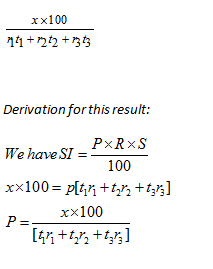
Example: The rate of interest for 3 years is 4%, 5years is 6%,1 years is 5%. If a man gets interest of Rs. 4700 for 9 years, calculate the principal amount?
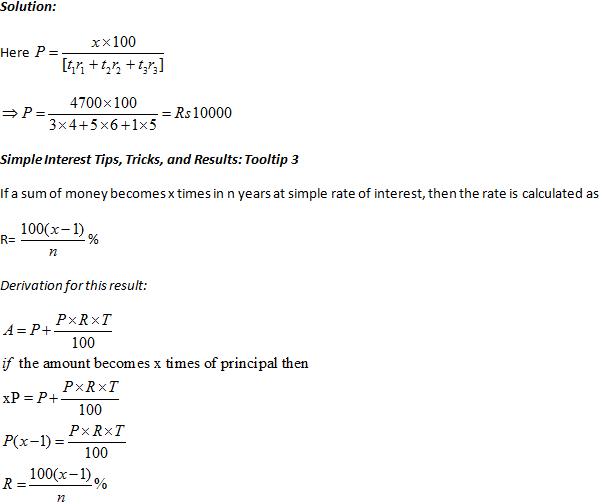
Example: A sum of money becomes 4 times in 20 years. Calculate the rate of interest.
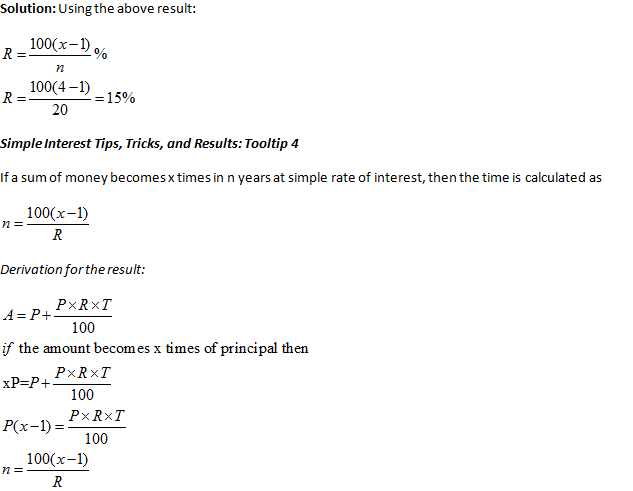
Example: A sum of money becomes 4 times in 20 years. Calculate the rate of interest.
Solution:
Using the above result:
R = [{100(x-1)}/n]%
R = [{100(4-1)}/20]=15%
Simple Interest Tips, Tricks, and Results: Tooltip 4
If a sum of money becomes x times in n years at simple rate of interest, then the time is calculated as
n= {100(x-1)/R}
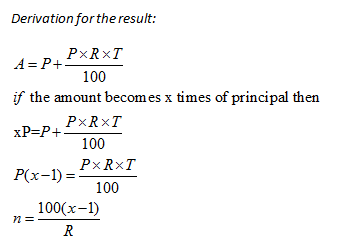
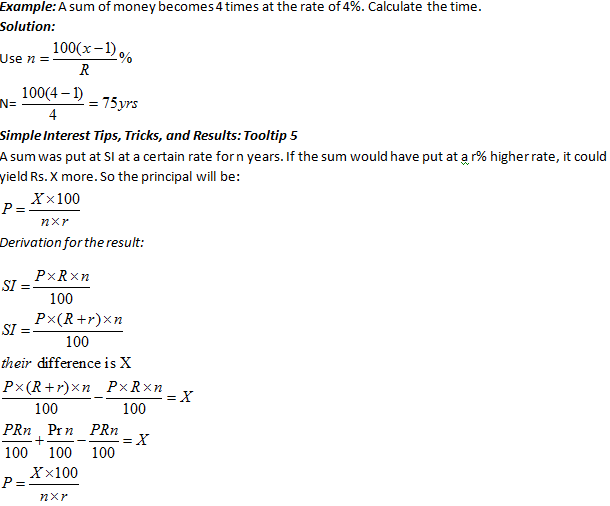
Example:A sum was put at SI at a certain rate for 3 years. If the sum would have put at a 2% higher rate, it would have yieldedRs 900 more. What will be the principal?
Solution:
Use the above formula:
P= {100X/(nX r)}
P= {(900 x 100)/(3 x2)} = Rs. 15000
This tooltip is a reverse of the last one. A sum is put at SI at a certain rate for n years. If the sum would have put at a r% lower rate, it could yield Rs X less. So the principal will be:
P= {100X/(n * r)}
Example: A sum was put at SI at a certain rate for 3 years. If the sum would have put at a 2% lower rate, it could yield Rs 900 less. What will be the principal?
Solution:
Using the formula, we arrive at the following:
P= {100X/(n * r)}
P= {(900*100)/(3*2)}
P = Rs. 15000
Tips, Tricks& Results for Simple Interest-2
The purpose of this article is to provide you with some useful tips and tricks that you can use for Simple Interest questions. Various applications and formulas based on this concept are explained here.
Simple Interest Tips, Tricks, and Results: Tooltip 1
Change in Simple Interest when time changes from T1 to T2 is given by the formula:

Change in Simple Interest when principal changes from P1 to P2 is given by the formula:

Change in Simple Interest When rate of interest changes from r1to r2 is given by the formula:

Example: Simple interest on Rs 200 increases by Rs 50 when time increases by 5 years. Find rate percent per annum.
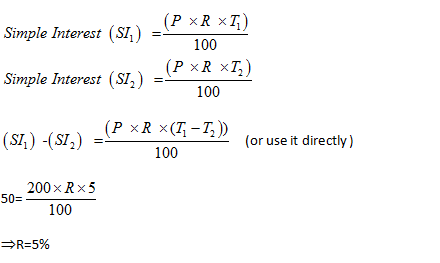
Example: If the SI on Rs 1000 be more than the interest on 2000 by Rs 20 in 4 years, find the rate per annum.
Solution: When principal changes from P1to P2
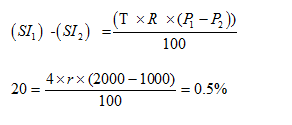
Simple Interest Tips, Tricks, and Results: Tooltip 2
If a person deposits A1 amount at r1% per annum and amount A2 at r2% per annum, then the rate of interest for the whole sum is {(A1r1 + A2r2)/(A1+A2)}
Example: A man deposits Rs.1000 at 4% per annum and Rs 2000 at 5% per annum, find the rate of interest for the whole sum.
Solution:
Method-1:
Using the formula for, Simple Interest (SI) = {(P x R x T)/100}
X = {(1000 x 4 x 1)/100} = 40
Y = (2000 x 5 x 1)/100 = 100
Total interest = 100+40=Rs. 140
Total principal =1000+2000=Rs.3000
Using the formula:
140 = {(3000 x R x 1)/100}
R = 14/3%
Method-2:
Applying above concept {(A1r1 + A2r2)/(A1+A2)} , the rate of interest is
[{(1000 x 4) + (2000 x 5)}/(1000 + 2000)]
= 14000/3000
14/3%
Simple Interest Tips, Tricks, and Results: Tooltip 3
A certain amount is invested for certain time but at different rates. When rate per annum is r1 the amount becomes x1 but at rate r2 per annum, the amount becomes x2 .
Time, t, is given by the formula:
t = {(x1 – x2)/(x2r1 – x1r2)}*100
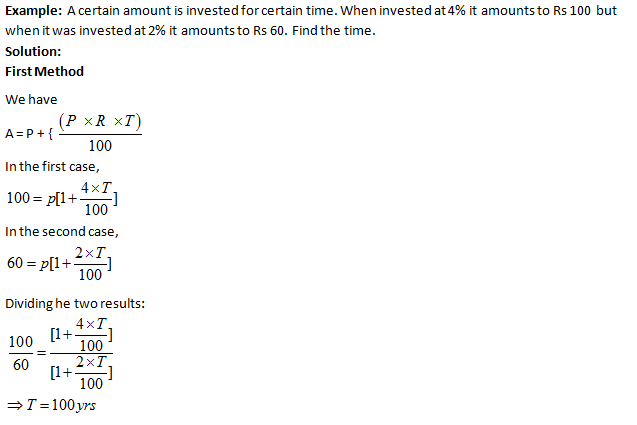
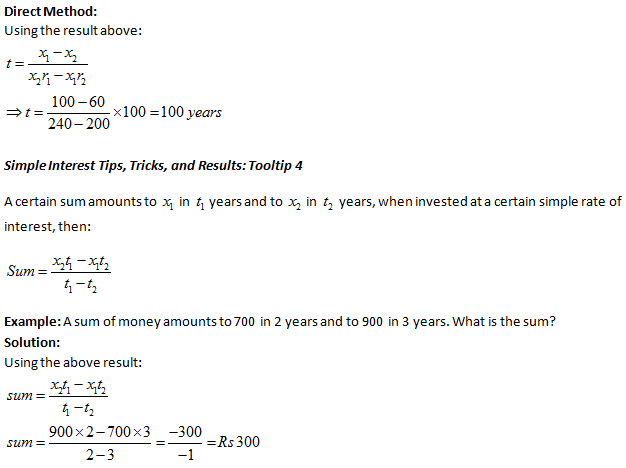
Simple Interest (SI)
If the interest on a sum borrowed for certain period is calculated uniformly, it is called simple interest(SI). (fix percentage of principal)
What is Principal (sum)
Principal (or the sum) is the money borrowed or lent out for a certain period. It is denoted by P.
What is Amount?
The Addition of Simple Interest and Principle is called the Amount.
A = S.I + P ( Principle )
Interest
Interest is the extra money paid by the borrower to the owner (lender) as a form of compensation for the use of the money borrowed calculated on the basis of Principle.
Time
This is the duration for which money is lend / borrowed.
Rate of Interest
It is the rate at which the interest is charge on principal.
What is Per annum means?
“Rate of interest R% per annum” means that the interest for one year on a sum. If not stated explicitly, rate of interest is assumed to be for one year.
Formulas Need to Remember
S.I =[( P X R X T )/( 100 )].
Where P = Principle, R = Rate of per annul, T = Number of years
From the above formula , we can derive the followings
P=(100×SI)/ RT
R=(100×SI)/ PT
T=(100×SI)/ PR

Some Tricks to Solve easily
Trick 1:- If a sum of money becomes “n” times in “T years” at simple interest, then the rate of interest per annum can be given be

Trick 2:- If an amount P1 is lent out at simple interest of R1% per annum and another amount P2 at simple interest rate of R2% per annum, then the rate of interest for the whole sum can be given by
![]()
Trick 3:- A sum of money at simple interest n1 itself in t1 year. It will become n2 times of itself in (If Rate is constant)

Trick 4:- In what time will the simple interest be “n” of the principal at “r %” per annum:-
rt =n x 100
Trick 5:- If a certain sum of money is lent out in n parts in such a manner that equal sum of money is obtained at simple interest on each part where interest rates are R1, R2, … , Rn respectively and time periods are T1, T2, … , Tn respectively, then the ratio in which the sum will be divided in n parts can be given by

Practice Problems On Simple Interest
- On a certain sum, the simple interest at the end of 5(1/3) years becomes 4/9 of the sum.What is the rate percent ?
A.5.5%
B.9.1%
C.7.6%
D.8.3%
E.10% - P is going to pay Rs.700 to Q, 7 months later at 6% annual simple interest, Q is going to pay Rs.550 to P, 12 months later at 8% annual simple interest, if they decide to settle the debts, who will pay what amount to whom ?
A.A, Rs.149
B.B,Rs.167
C.A, Rs.155
D.B, Rs.197
E.None of these - A father left a will of Rs.5 lakhs between his two daughters aged 10 and 15 such that they may get equal amounts when each of them reach the age of 21 years. The original amount of Rs.5 lakhs has been instructed to be invested at 10% p.a. simple interest. How much did the elder daughter get at the time of the will?
A.Rs.2,04,797
B.Rs.3,05,890
C.Rs.1,90,00
D.Rs.4,00,700
E.Rs.2,46,870 - Two equal some of money were invested at an annual rate of 10%, One sum at simple interest and other at compound interest, If the difference between the interest after 2 years was Rs.100, What were the sum invested ?
A.25,000
B.100000
C.20,000
D.10,000
E.50,000 - A man invests Rs.8000 for 5 years at 5% p.a. Simple Interest interest reckoned yearly. Income tax at the rate of 20% on the interest earned is deducted at the end of each year. Find the amount at the end of the fifth year.
A.Rs.10,500
B.Rs.10,500
C.Rs.9,600
D.Rs.10,000
E.None of these - Ajay bought Rs.11,000 from a bank to buy a car at 12% simple Interest. If he paid $ 6,600 as interest while clearing the loan, find the time for which the loan was given.
A.7
B.3
C.4
D.5
E.6 - Tarun invested an amount of Rs. 10000 at the simple interest rate of 8% per annum and another amount at the simple interest rate of 20% per annum. The total interest earned at the end of one year on the total amount invested became 12% per annum. Find the total amount invested.
A.Rs.12,000
B.Rs.15000
C.Rs.5,000
D.Rs.10,000
E.None of these - If simple interest on a certain sum of money for 6 years at 5% per annum is same as the simple interest on Rs. 650 for 9 years at the rate of 12% per annum then the sum of money is
A.Rs.2340
B.Rs.3240
C.Rs.2400
D.Rs.3500
E.None of these - Kailash borrowed some money at the rate of 5% p.a. for the first three years, 8% p.a. for the next five years and 11% p.a. for the period beyond eight years. If the total interest paid by him at the end of eleven years is Rs. 8800, how much money did he borrow?
A.Rs.7500
B.Rs.8000
C.Rs.9600
D.Rs.10,000
E.Rs.7,000 - If the annual rate of simple interest increases from 8% to 13%, a man’s yearly income increases by Rs. 4800. His principal (in Rs.) is:
A.Rs.90,000
B.Rs.96,000
C.Rs.88,000
D.Rs.1,00,000
E.None of these
- Out of Rs. 60,000 that Rahul has, he lends Rs. 10,000 at 11/2 % per annum simple interest and Rs. 32,000 at 6% per annum simple interest. He lends the remaining money at a certain rate of interest so that he gets total annual interest of Rs. 4000. The rate of interest per annum, at which the remaining money is lent, is?
A.5%
B.7.5%
C.8%
D.8.5%
E.10% - Vivek invests Rs 15000 as fixed deposit at a bank at the rate of 10% per annum SI. But due to some pressing needs he has to withdraw the entire money after 5 years, for which the bank allowed him a lower rate of interest. If he gets Rs 8250 less than what he would have got at the end of 10 years, the rate of interest allowed by the bank is
A.8%
B.8.5%
C.9%
D.9.5%
E.10% - A father left a will of Rs.55 lakhs between his two sons aged 8.5 and 16 such that they may get equal amounts when each of them reach the age of 21 years. The original amount of Rs.55 lakhs has been instructed to be invested at 10% p.a. SI. How much did the elder son get at the time of the will?
A.25 lakh
B.26 lakh
C.28 lakh
D.33 lakh
E.36 lakh - Manish borrows 8000 at simple interest from a money lender. At the end of 3 years, he again borrows 7000 and closes his account after paying 8415 as interest after 8 years from the time he made the first borrowing. Find the rate of interest.
A.6%
B.6.5%
C.8%
D.8.5%
E.9% - A portion of Rs.8500 is invested at a8% per annum, while the remainder is invested at a 3% per annum. If the annual income from the portion earning a 8% per annum is thrice that of the other portion, what is the total income from the two investments after one year?
A.Rs.350
B.Rs.370
C.Rs.450
D.Rs.480
E.Rs.520 - Raghu lends Rs 50,000 of two of his friends. He gives Rs 30,000 to the first at 6% p.a. simple interest. He wants to make a profit of 10% on the whole. The simple interest rate at which he should lend the remaining sum of money to the second friend is
A.8%
B.16%
C.11%
D.17%
E.19% - The rate of Simple Interest in SBI & BOB are in the ratio of 5:7. Gokul wants to deposit his total savings in two banks in such a way that he receive equal half-yearly interest from both banks.He should deposit in both banks SBI & BOB in the ratio of
A.4:5
B.7:5
C.9:5
D.8:5
E.5:9 - Vinay borrowed some money for one year at 8% per annum simple interest and after 18 months , he again borrowed the same money at a Simple Interest of 32% per annum. In both the cases, he paid Rs.5452. Which of the following could be the amount that was borrowed by Hari in each case if interest is paid half yearly?
A.3900
B.4200
C.4500
D.4700
E.None of the Above - Ravi borrows a sum of Rs.2000 at the beginning of a year. After four months Rs.2600 more is borrowed at a rate of interest double the previous one. At the end of one year, the sum of interest on both the loans is Rs.494. What is the first rate of interest per annum?
A.8.5%
B.9%
C.9.5%
D.12%
E.None of the Above - Kumar fixes the rate of interest 5% per annum for first 3 years and for the next 4 years 6 percent per annum and for the period beyond 7 years, 7.5 percent per annum. If Mr. Kumar lent out Rs.1800 for 11 years, find the total interest earned by him?
A.Rs.1422
B.Rs.1242
C.Rs.1244
D.Rs.1342
E.None of the Above
- Vikram invests some money in three different schemes for 4 years, 8 years and 12 years at 10%, 15% and 20% Simple Interest respectively. At the completion of each scheme, he gets the same interest. The ratio of his investments is
A. 6 : 2 : 1
B. 5 : 2 : 1
C. 5 : 2 : 3
D. 5 : 2 : 7
E. None of the Above - Mr. Ravi finds that due to a fall in the rate of interest from 9% to 6%, his yearly income diminishes by Rs.267. His capital is ?
A. Rs.3800
B. Rs.8400
C. Rs.8600
D. Rs.8900
E. None of the Above - Out of Rs. 50,000 that a man has, he lends Rs. 8,000 at 11/2 % per annum simple interest and Rs. 24,000 at 6% per annum simple interest. He lends the remaining money at a certain rate of interest so that he gets total annual interest of Rs. 3,680. The rate of interest per annum, at which the remaining money is lent, is ?
A. 5%
B. 7%
C. 10%
D. 12%
E. None of the Above - Vikram lends Rs 30,000 of two of his friends. He gives Rs 15,000 to the first at 6% p.a. simple interest. He wants to make a profit of 10% on the whole. The simple interest rate at which he should lend the remaining sum of money to the second friend is
A. 8%
B. 16%
C. 12%
D. 14%
E. None of the Above - Suresh lends 40% of his money at 15% per annum, 50% of the rest at 10% per annum and the rest at 18% per annum rate of interest. What would be the annual rate of interest, if the interest is calculated on the whole sum?
A. 18.5%
B. 14.4%
C. 16.5%
D. 19.5%
E. None of the Above - Ajay borrows Rs 1000 at the rate of 12% per annum simple interest and Babu borrows Rs 1050 at the rate of 10% per annum simple interest. In how many years will their amounts of debts be equal?
A. 18/5
B. 10/3
C. 22/3
D. 10/5
E. None of the Above - A sum of Rs. 8800 is to be divided among three brothers Anil, Deepak and Ramesh in such a way that simple interest on each part at 5% per annum after 1, 2 and 3 year respectively remains equal. The share of Anil is more than that of Ramesh by?
A. Rs. 3200
B. Rs. 2500
C. Rs. 3000
D. Rs. 2700
E. None of the Above - Mayank invested a certain sum of money in a simple interest bond, that value grew to Rs. 300 at the end of 3 year and to Rs. 400 at the end of another 5 year. Then what was the rate of interest in which he invested his sum?
A. 12%
B. 12.5%
C. 6.67%
D. 8.33%
E. None of the Above - Vivek took a loan from the bank at 8% per annum, and was supposed to pay a sum of Rs.2500 at the end of 4 years. If the same sum is cleared off in four equal annual instalments at the same rate, then the amount of annual instalment will be?
A. Rs.558
B. Rs.978
C. Rs.766
D. Rs.856
E. None of the Above - Sachin invested some amount at the rate of 12% simple interest and a certain amount at the rate of 10% simple interest. He received yearly interest of Rs.140. But if he had interchanged the amounts invested, he would have received Rs.4 more as interest. How much did he invest at 12% simple interest?
A. Rs. 750.65
B. Rs. 545.45
C. Rs. 850.65
D. Rs. 465.45
E. None of the Above
- Bharat borrowed Rs.180,000 on a condition that he had to pay 7.5% interest every year. He also agreed to pay the principal in equal annual instalments over 21 years. After a certain number of years, however, the rate of interest has been reduced to 7%. It is also known that at the end of the agreed period, he will have paid in all Rs.2,70,900 in interest. For how many years does he pay at the reduced interest rate?
A. 10 years
B. 12 years
C. 13 years
D. 14 years
E. None of the Above - Ankita borrows Rs.7000 at simple Interest from a lender. At the end of 3 years, she again borrows Rs.3000 and settled that amount after paying Rs.4615 as interest after 8 years from the time she made the first borrowing. what is the rate of interest?
A. 5.5%
B. 9.5%
C. 7.5%
D. 6.5%
E. None of the Above - Hari borrowed some money for one year at 6% per annum simple interest and after 18 months , he again borrowed the same money at a Simple Interest of 24% per annum. In both the cases, he paid Rs.4704. Which of the following could be the amount that was borrowed by Hari in each case if interest is paid half yearly?
A. 4000
B. 3000
C. 4400
D. 4200
E. None of the Above - Ravi lent out a part of Rs. 38800 is lent out at 6% per six months. The rest of the amount is lent out at 5% per annum after one year. The ratio of interest after 3 years from the time when first amount was lent is 5:4. Find the second part that was lent out at 5%.
A. 28500
B. 30080
C. 20500
D. 28800
E. None of the Above - Harshita lent out some money at 6% Simple Interest per annum. After one year, Rs.6800 is repaid and the rest of the amount is repaid at 5% per annum. If the second year’s interest is 11/20 of the first year’s interest, find what amount of money was lent out.
A. 18500
B. 10080
C. 17000
D. 18000
E. None of the Above - Vikram borrows a sum of Rs.1500 at the beginning of a year. After four months Rs.2100 more is borrowed at a rate of interest double the previous one. At the end of one year, the sum of interest on both the loans is Rs.416. What is the first rate of interest per annum?
A. 5.5%
B. 4.5%
C. 6.7%
D. 7.3%
E. None of the Above - Rahul invested a sum of money at Simple Interest at a certain rate of interest for three years. Had it been invested at a 4% higher rate, it would have fetched Rs.480 more. Find out the Principal amount that was invested by Rahul?
A. 3000
B. 4000
C. 5000
D. 4500
E. None of the Above - Rakesh fixes the rate of interest 6% per annum for first 3 years and for the next 4 years, 7 percent per annum and for the period beyond 7 years, 7.5 percent per annum. If Mr. Rakesh lent out Rs.1500 for 11 years, find the total interest earned by him?
A. Rs.1100
B. Rs.1200
C. Rs.1140
D. Rs.1350
E. None of the Above - An equal amount of sum is invested in two schemes for four years each, both offering simple interest. When invested in scheme A at 8% per annum the sum amounts to Rs.5280. In scheme B, invested at 12% per annum it amounts to Rs.5920. What is the total sum invested?
A. 5000
B. 9000
C. 7000
D. 8000
E. None of the Above - Simple Interest on a certain sum at a certain annual rate of interest is 16% of the sum. If the numbers representing rate per cent and time in years be equal, then the rate of interest is?
A. 2%
B. 4%
C. 6%
D. 8%
E. None of the Above









